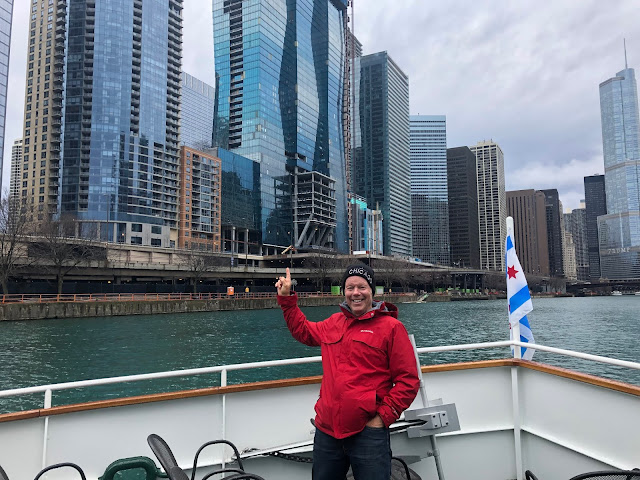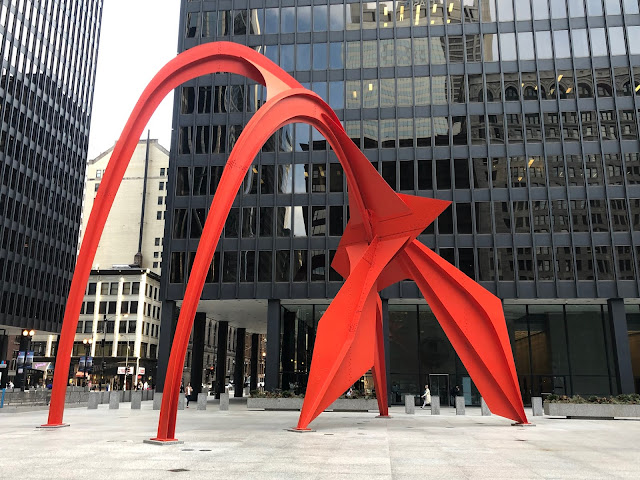CHICAGO! CHICAGO! Tall buildings, great art, the Cubs, friendly people, the Blues! April found Maria and I in the Windy City on a self-guided tour that we'll never forget. Chicago is truly a majestic city - birthplace of the skyscraper, proud home to the Chicago Cubs, and site of a vibrant cultural life. Although we only stayed for four days, I'm already planning to do a Hoffy Tour to this friendly and exciting town. People say Chicagoans are really nice and helpful. We second that opinion!
 |
Hoffy on a cold April afternoon on the Architecture Center's famous River Cruise.
Orientation: We found Chicago quite navigable on foot. From our hotel on Michigan Avenue in The Loop, it was easy to know which way to go. Right across the street is Lake Michigan with its wonderful Millennium Park and museums. West was the business, shopping and entertainment district. North was the Chicago River, Navy Pier and the Magnificent Mile of famous shopping. South was the Art Institute and Field and Science Museums and eventually the University of Chicago. We obviously did not explore the City's many neighborhoods (except Wrigleyville), but we were so thrilled with what we saw downtown. Here are my observations:
1. City of Architecture: That phrase rings true. Although New York may have a few taller skyscrapers, Chicago has a greater diversity of styles and more space in which to view them. It's almost as if each building is sited so that it can be viewed from all sides. Also, Chicago benefits from its river system which opens up a viewing corridor of the tremendous skyline.
|
 |
Although New York may have more and taller skyscrapers, Chicago's skyline is more diverse,
easier to see and more beautiful. |
 |
The world's first skyscraper, built in 1886, was the result of the invention of the steel skeleton frame, freeing large buildings from heavy masonry bases.
For architecture lovers, there is no better city. Start your visit at the wonderful new CHICAGO ARCHITECTURE CENTER located right on the Chicago River. This museum has two levels: one with a film on the evolution of the city with the nation's largest urban model; the second contains models of skyscrapers around the world and exhibits on the future of the city. A nice feature was the well-appointed Museum Store. Who can be without a Frank Lloyd Wright coaster? From this wonderful Center, the views are magnificent and you can sign up a wide variety of walking, bus and boat tours.
 | | The Chicago Architecture Center is a great place to learn, book a tour or just gaze at the skyline. |
 | Just north of the Architecture Center, Michigan Avenue Bridge crosses the Chicago River. Just beyond
the famous bridge houses are two of the city's most famous early 1900s skyscrapers: on the right, the Tribune
Building with its Art Deco body and Gothic top; on the left, is the fanciful Classical-Revival Wrigley Building. |
|
 |
| The Money Museum in the Federal Reserve Bank of Chicago had some excellent educational exhibit and some photo ops! |
 |
| Ever wondered what a million dollars in ones looks like? Wonder no more! |
Art Deco Chicago - The Art Deco period flourished from the mid-1920s to the end of the 1930s and Chicago has many fine examples. I've always marveled at the beautiful, complex and expensive decoration was used during this period in lobbies, on elevators, on walls and on building tops. The designs are stylized, optimistic and complex with influences from Art Nouveau Europe, Egypt, Mesoamerica, and nature. Along Michigan Avenue, the Loop and the Chicago River are many fine examples of this bountiful period.
 |
| Elevators are often clad in stylized Art Deco figures, many of which are seen in profile. |
 |
This figure of Ceres, the Roman God of Cereal, appropriately adorns the Chicago Board of
Trade Building. As with many Art Deco figures, the human features are simplified and glorified.
In this case, Ceres has no face because the architects felt that since no other building would be as tall,
people wouldn't notice! |
 |
Classic Art Deco "stepped up" tower, allowing light to the street and showing off a champagne bottle
top adorned in actual golf leaf. |
 |
| The massive Mercantile Mart on the Chicago River is the largest commercial building in the world. Notice the vertical emphasis of the windows and the "stepped-back", ziggurat look of the central tower and corner piers. |
 |
| Art Deco period buildings often features murals and wall sconce lighting. |
 |
Streamline Moderne styles, the end of the Art Deco period, featured designs which idolized transportation
and progress. Here we are in the Chicago Board of Trade Building. Why not design an ocean liner into the flooring? |
How Tall Can You Go? Chicago invented the skyscraper and then New York went taller with the Chrysler, Empire State Building and then World Trade Center buildings. However, the Sears Tower (now called the Willis Tower), completed in 1973, topped out at 110 stories making it the tallest building in the world for almost 25 years. Maria and I ascended the tower to Skydeck for its amazing views and exhibits. And, no, we didn't hang out on the projecting platform!
 |
| The black behemoth of the Willis Tower dwarfs the competition! |
 |
Notice the two clear plastic platforms at the 103rd story on the left side of the building? They
are for visitor, thrill-seekers who want to look 1400 feet straight down. |
 |
From the Willis Tower's Skydeck (like LA's Skyspace), views of the skyline are unparalleled. Look at the tremendous
diversity of architecture and Lake Michigan beyond. |
Fanciful Shapes: One of the most interesting aspects of Chicago's architecture is its diversity. There are early Beaux Art skyscrapers, Gothic Revival, Art Deco, International Style, Post-modern and contemporary towers. Something for every taste!
 |
| The 2007 Aqua Tower by Jean Gang of Studio Gang Architects was my favorite. |
 |
| At 82 stories, the mixed-use Aqua Tower is the tallest building designed by a woman. |
 |
| This post-modern tower sports a pseudo-Greek temple front at the top. |
 |
The Marina Towers by Goldberg shows no straight lines. The use of unpainted cement
was popular in the 1960s. |
 |
| The sleek Trump Tower (20050 is one of the tallest buildings in the city at 98 stories. |
Great Public Art - Chicago also prides itself on its stellar public art. My favorite, in fact the most engaging public art I have ever seen, was right out in front of our hotel in Millennium Park: the "Bean". Actually called "Cloud Gate", this 2004 sculpture by Anish Kapoor delights visitors daily. This shiny stainless steel shape reflects the sky, the skyline and the many people taking pictures of themselves reflected in the "Bean". Like truly great art, it connects strangers who want to talk about it, walk around, under and through it. What a masterpiece!
 |
How could you not love the "Bean"? It engages people of all ages.
|
 |
| The Chicago Picasso was dedicated in 1967. This example of steel cubism quickly became a city landmark. |
 |
Alexander Calder's Flamingo is beautifully framed by the dark glass building behind it.
City of Art and Culture - With so many museum and so little time, we concentrated on what is considered the second most important art museum in the nation - the Art Institute of Chicago. There is more to see than one day allowed but the impressionist and post-impressionist collections were my favorite.  | American Gothic (1930) by Grant Wood is an American classic. The models for the painting
were his sister and dentist.
 | Van Gogh's The Bedroom is considered to be one of the most famous depictions of a bedroom in the history of art. His other two depictions are in Paris and Amsterdam.
 | | Seurat's painting from 1884 - A Sunday in La Grande Jatte - is a masterpiece in pointillism. |
 | | Edward Hopper's 1942 Nighthawks is another of the artists bleak urban scenes. |
Had we more time, we certainly would have taken in the Museum of Science and Industry, located in the from the famous 1893 Chicago Columbian Exposition or the Field Museum of Natural History. Instead we decided to see Frank Lloyd Wright's famous prairie-style Robie House.
Frank Lloyd Wright's Chicago - We took a short taxi ride south to Hyde Park to see Frank Lloyd Wright's prairie-style masterpiece - The Robie House - adjacent to the beautiful Gothically inspired University of Chicago. The horizontality of the home with its projecting eaves, clerestory windows and decorative bands was meant to reflect the flatness of the prairie. As in other Frank Lloyd Wright homes, the interior is a work of art with geometrically-patterned leaded windows, furniture, lamps, and rugs. It was hard to believe that the home was built between 1909-1910 because its modernity was in stark contrast to the surrounding Victorian and period revival homes. So ground-breaking was this home that it was declared a National Historic Landmark in 1963 and was on the first list of the National Register of Historic Places in 1966.  | Unlike the more vertical Victorian homes of the ear, Wright's Robie House celebrates horizontality.
|
 | | Notice the geometric patterns in the windows as well as on the rugs. The custom lights and sunken fireplace were common Wrightian touches. |
 | Wright's dining room tables were ultra modern and apparently not very comfortable. Notice the decorative
lighting at the table corners echoing the geometric patterns of the leaded windows.
|
 | The original Gothic architecture of the University of Chicago (1892) was modeled after Oxford University in England.
|
THE CUBS, WRIGLEY FIELD, THE BLUES and DEEP-DISH PIZZA - It's hard to go to Chicago and not go a Cub's game at Wrigley Field. We loved the vintage stadium and vibrancy of the surrounding neighborhood with its colorful bars, restaurants and shops. My wife said Wrigleyville looked like a stage set with all the human activity. I noticed the lack of surface parking lots and cars which allows more room for people and active street life. April can be cold in Chicago but that didn't prevent the hometown Cubs from hitting four homers against our poor Angels.
 | | I think I had the only red jacket in a sea of blue-jerseyed Cubs fans! |
| | Gorgeous day at the nation's second-oldest ballpark (Fenway Park - 1912 is the oldest).Add caption |
 | We loved the great music at Buddy Guy's Legends Blues Club. Cover charge
was $10 and the food was good.
|
 | We couldn't finish our delicious deep-dish pizza from Giordano's.
|
|
|
|

